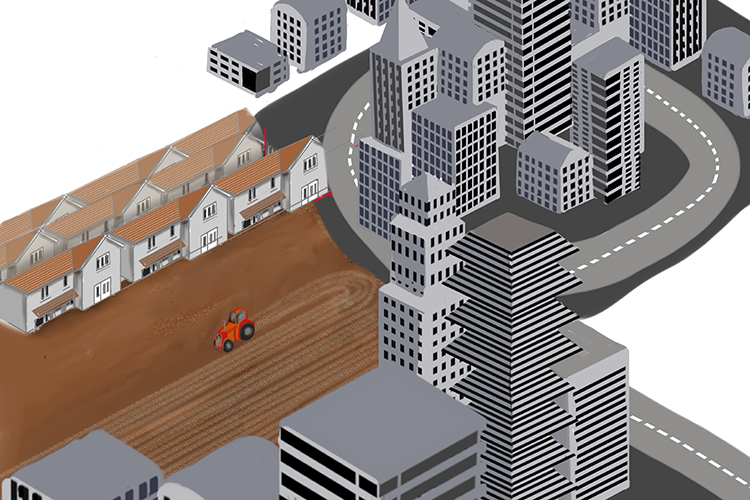Brownfields: The AP Human Geography Definition You Need to Know
The term “brownfield” is a critical concept in AP Human Geography, representing a complex interplay of urban development, environmental concerns, and economic revitalization. Understanding brownfields is crucial for grasping how human activities shape landscapes and the challenges faced in creating sustainable urban environments. This article provides a comprehensive overview of brownfields, their significance, and their implications for your AP Human Geography exam and beyond.
What Exactly is a Brownfield?
At its core, a brownfield is a previously developed site that is not currently in use and may be contaminated. This contamination, often from past industrial or commercial activities, poses environmental risks and can deter redevelopment. Think of abandoned factories, old gas stations, or former industrial sites. The key characteristics of a brownfield are:
- Prior Development: The site was previously used for industrial, commercial, or other non-residential purposes.
- Potential Contamination: The site may contain hazardous substances, pollutants, or other forms of environmental contamination.
- Underutilized or Abandoned: The site is typically vacant, underused, or slated for demolition.
- Redevelopment Challenges: The presence of contamination and potential liability often creates obstacles to redevelopment.
Why are Brownfields Significant in AP Human Geography?
Brownfields are significant in AP Human Geography because they represent a multifaceted problem with far-reaching consequences:
- Environmental Degradation: Brownfields contribute to soil and water contamination, impacting ecosystems and human health.
- Urban Sprawl: The presence of brownfields can contribute to urban sprawl as developers bypass contaminated sites and build on greenfield land (undeveloped land), leading to increased commuting distances and environmental impact.
- Economic Disinvestment: Brownfields can depress property values and discourage investment in surrounding areas, leading to economic decline.
- Social Justice Issues: Brownfields are often located in low-income communities, raising concerns about environmental justice and disproportionate exposure to environmental hazards.
- Urban Revitalization Opportunities: Brownfield remediation and redevelopment offer opportunities to revitalize urban areas, create jobs, and promote sustainable development.
- Land Use Planning and Policy: Brownfields highlight the importance of effective land use planning, environmental regulations, and government incentives to address contamination and promote responsible land management.
The Brownfield Remediation Process: A Closer Look
Addressing the challenges presented by brownfields involves a multi-step process known as remediation. This process can vary depending on the type and extent of contamination, but generally includes the following stages:
- Site Assessment: Identifying and characterizing the type, extent, and location of contamination. This often involves soil and water testing.
- Remedial Investigation/Feasibility Study (RI/FS): Determining the best methods to clean up the contamination. This may involve evaluating several cleanup options.
- Cleanup Plan Development: Developing a plan for cleaning up the site, including the chosen remediation methods and cleanup goals.
- Remediation: Implementing the cleanup plan, which may involve:
- Excavation and Removal: Removing contaminated soil and materials.
- Containment: Preventing the spread of contamination through methods like capping or barriers.
- Treatment: Using chemical, biological, or physical processes to remove or neutralize contaminants.
- Monitoring: Regularly monitoring the site to ensure that the cleanup is effective and that the contamination is not recurring.
- Redevelopment: Once the site is deemed safe, it can be redeveloped for a variety of uses, such as residential, commercial, or recreational purposes.
Brownfield Redevelopment Strategies
Successful brownfield redevelopment often requires a combination of strategies:
- Government Incentives: Tax credits, grants, and loans to offset the costs of remediation and redevelopment.
- Public-Private Partnerships: Collaboration between government agencies, developers, and community stakeholders.
- Brownfield Assessments: Conducting environmental assessments to determine the extent of contamination and identify potential cleanup strategies.
- Liability Protection: Providing legal protection to developers from liability for past contamination.
- Community Involvement: Engaging local communities in the planning and redevelopment process.
- Zoning Changes: Modifying zoning regulations to allow for a wider range of potential uses on redeveloped brownfield sites.
Brownfields vs. Greenfields: Understanding the Difference
It’s important to differentiate between brownfields and greenfields in your AP Human Geography studies.
- Brownfields: Previously developed sites, often contaminated, requiring remediation before redevelopment.
- Greenfields: Undeveloped land, often agricultural or natural areas, that are considered pristine and not contaminated.
The key difference lies in their prior use and the presence of contamination. The choice between developing a brownfield or a greenfield has significant implications for urban planning, environmental sustainability, and economic development.
Conclusion: Mastering Brownfields for AP Human Geography
Understanding the definition, significance, and remediation process of brownfields is crucial for success in AP Human Geography. Brownfields represent a complex challenge, but also offer significant opportunities for sustainable urban development, environmental restoration, and economic revitalization. By grasping the key concepts and the factors that influence brownfield redevelopment, you’ll be well-prepared to analyze urban landscapes, evaluate the environmental and social impacts of development, and understand the principles of responsible land management on your AP exam.
Frequently Asked Questions (FAQs)
1. What are some common contaminants found on brownfield sites?
Common contaminants include heavy metals (lead, mercury, arsenic), petroleum products (gasoline, oil), solvents, pesticides, and asbestos.
2. What are the benefits of redeveloping brownfields?
Redeveloping brownfields can reduce urban sprawl, revitalize communities, create jobs, improve environmental quality, increase property values, and promote sustainable development.
3. What are the challenges of redeveloping brownfields?
Challenges include high remediation costs, potential liability for contamination, complex regulatory processes, community concerns, and financing difficulties.
4. How do brownfields relate to the concept of environmental justice?
Brownfields often disproportionately affect low-income and minority communities, raising environmental justice concerns due to increased exposure to environmental hazards and reduced access to environmental amenities.
5. Can brownfields be redeveloped for any purpose?
No, the potential uses for a brownfield depend on the nature and extent of the contamination, the cost of remediation, and local zoning regulations. Some sites may be suitable for residential development, while others may be better suited for commercial, recreational, or industrial uses.




